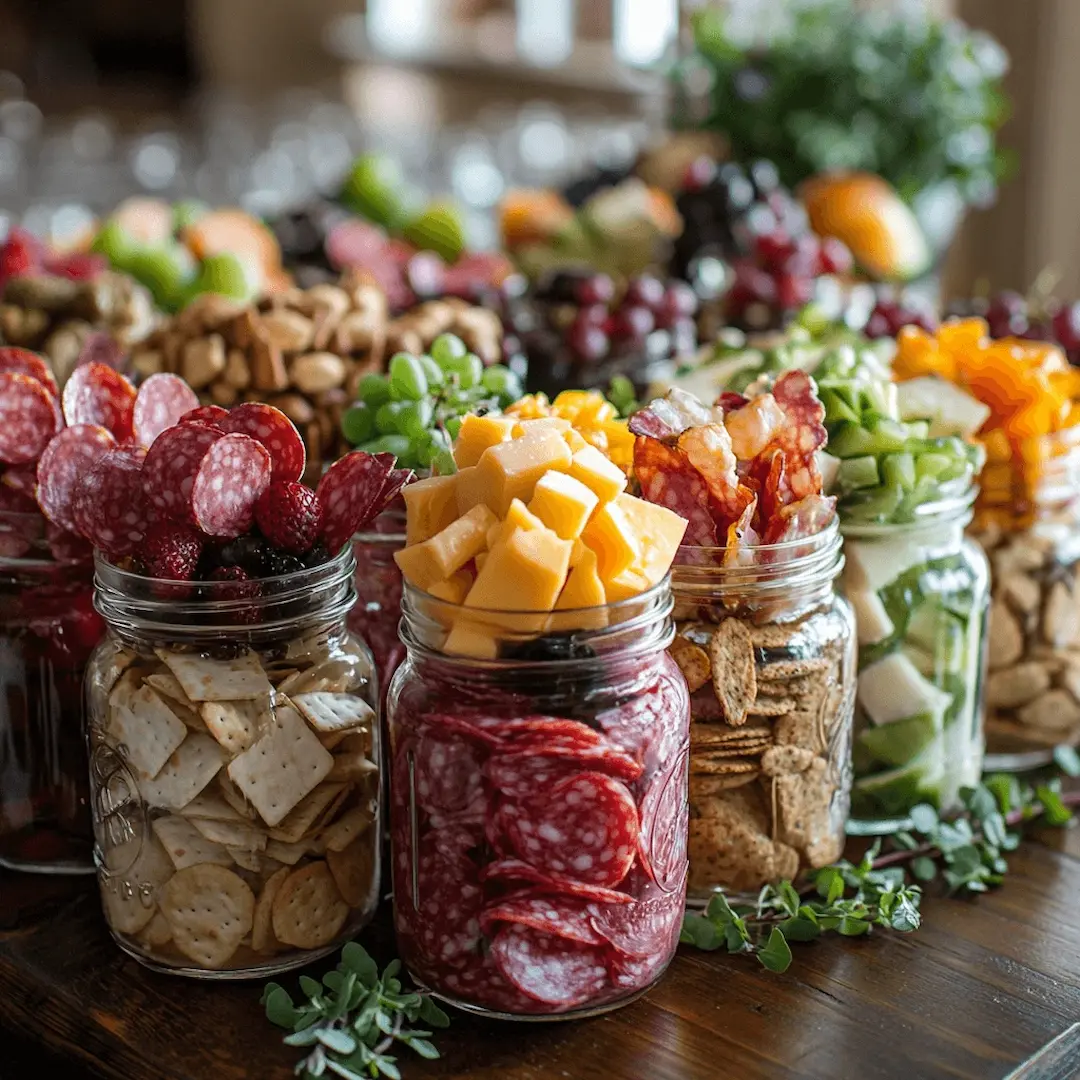Introduction
Individual Charcuterie Cups have quickly become a popular and trendy alternative to traditional charcuterie boards. These bite-sized servings offer a creative way to enjoy the classic charcuterie experience with a personal touch. Whether you’re hosting a casual get-together, attending a picnic, or planning a more formal event, individual charcuterie cups offer convenience, style, and versatility. In this guide, we’ll walk you through everything you need to know about assembling the perfect individual charcuterie cups, from the essential ingredients to presentation tips and creative ideas for any occasion.
What Are Individual Charcuterie Cups?
What is a Charcuterie Cup?
A charcuterie cup is essentially a single-serving version of the traditional charcuterie board. It is a small, portable serving filled with a variety of delicious and visually appealing snacks such as cured meats, cheeses, fruits, crackers, nuts, and more. These individual portions offer a personal touch and allow each guest to enjoy their own curated selection of flavors without the need to share. The versatility of charcuterie cups means you can tailor them to any event or dietary preference, making them a great choice for weddings, parties, or even casual gatherings.
Why Choose Individual Charcuterie Cups?
Individual charcuterie cups have quickly gained popularity for several reasons. They provide portion control, making them ideal for managing serving sizes at events. This eliminates waste and ensures each guest receives just the right amount.
Additionally, these cups offer a more hygienic and convenient format. Guests can enjoy the variety of a traditional charcuterie board without the need for communal sharing, which is especially important at large gatherings.
Charcuterie cups are perfect for outdoor events where platters can be difficult to manage. Their small, compact size makes them a hit at buffets and as appetizers at formal dinners.
They are also highly customizable. You can easily adapt them to fit dietary preferences, making them inclusive for all guests. Whether vegetarian, gluten-free, or following another specific diet, these cups can accommodate everyone’s needs.
If you’re looking to create a festive and vibrant spread, check out our Easter Charcuterie Board Guide for more creative ideas on designing your charcuterie arrangements.
Table of Contents
Table of Contents
Essential Ingredients for Charcuterie Cups

To complement your individual charcuterie cups, consider making Shakshuka with Spinach and Cheese, a flavorful and filling option that pairs perfectly with the variety of meats and cheeses you’ll be serving
Meats for Charcuterie Cups
A well-rounded charcuterie cup includes a selection of high-quality cured meats. The meats you choose can be tailored based on your preferences, but some classics include:
- Salami: The most common meat found in charcuterie, offering a bold, savory flavor.
- Prosciutto: This dry-cured ham adds a delicate, slightly sweet taste, making it a great complement to other meats and cheeses.
- Pepperoni: A spicier option for those who enjoy a little heat in their bites.
- Capicola or Soppressata: Both provide a richer, more robust flavor.
The key is to balance salty and savory options, offering variety so guests can experience different textures and tastes in each bite.
Cheeses for Charcuterie Cups
Cheese is the heart of any charcuterie spread, and charcuterie cups are no exception. Choose a selection that contrasts both in texture and flavor. Here are a few must-have options:
- Brie: A soft, creamy cheese that pairs wonderfully with both sweet and savory elements.
- Goat Cheese: Slightly tangy and crumbly, goat cheese adds variety to your cup and pairs well with honey or fruit preserves.
- Cheddar: A sharp, firm cheese that adds a savory, somewhat tangy flavor to the mix.
- Manchego or Gouda: These firm cheeses offer a nutty, slightly sweet taste and work well alongside milder cheeses.
When assembling your cups, aim for a variety of textures—soft, firm, creamy, and crumbly—to keep the flavors exciting.
How to Assemble Individual Charcuterie Cups
Step-by-Step Guide to Assembling Charcuterie Cups
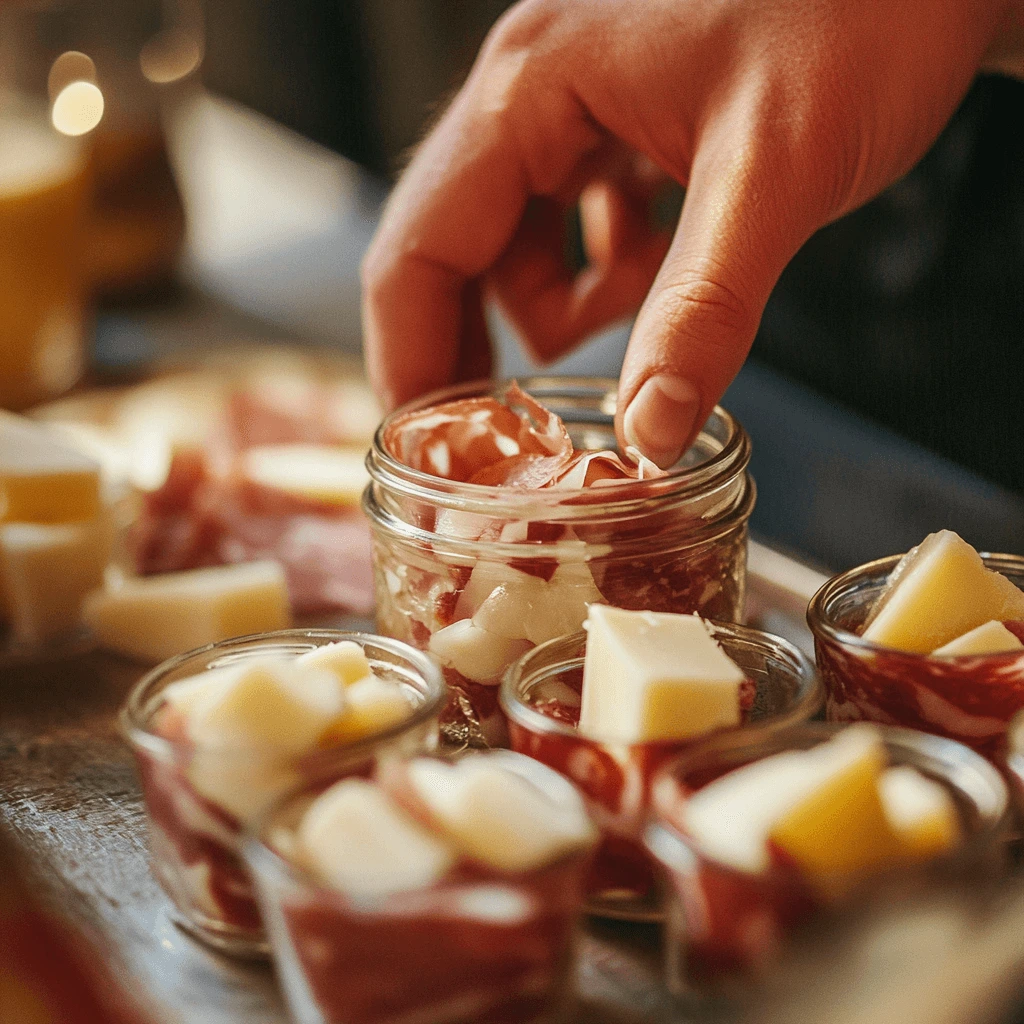
For a healthy and vibrant pairing, consider serving smoothie bowls alongside your individual charcuterie cups. Check out our Smoothie Bowl Guide for ideas on how to make the perfect blend.
Assembling individual charcuterie cups can be a fun and creative process. Here’s a simple guide to help you get started:
- Choose Your Container: Select a small cup or jar that allows enough room for layering. Mason jars are a popular choice, but small glass cups, plastic cups, or even paper cones can work well.
- Layer the Larger Items First: Begin with the meats and cheeses, as these take up the most space and provide the structure for the rest of your cup. Roll up the slices of prosciutto or capicola for an elegant look, and wedge the cheese slices between them.
- Add Crackers or Breads: Next, layer in crackers or small breadsticks. Make sure they are easily accessible but not so large that they overpower the cup’s design.
- Fill with Fruits and Vegetables: Fill in the spaces with fresh fruits like grapes, figs, or strawberries, and crunchy vegetables like carrots or cherry tomatoes.
- Finish with Nuts and Garnishes: Complete your cup with a sprinkle of nuts, such as almonds or pistachios, and perhaps a small garnish like rosemary or thyme to add a burst of color and flavor.
Presentation Tips for Stunning Charcuterie Cups
When it comes to presentation, a little creativity goes a long way. Try to alternate colors and textures in your layers to create an appealing look. For example, pair the soft white of brie with the deep reds of prosciutto or the green of fresh herbs. You can also drizzle a small amount of honey or balsamic glaze over the top for added elegance and flavor. Additionally, if you’re preparing charcuterie cups for a themed event, use matching containers or add small decorations to tie everything together. Small touches like edible flowers, mint leaves, or colored toothpicks can make the cups look even more festive.
What Goes Well in a Charcuterie Cup?
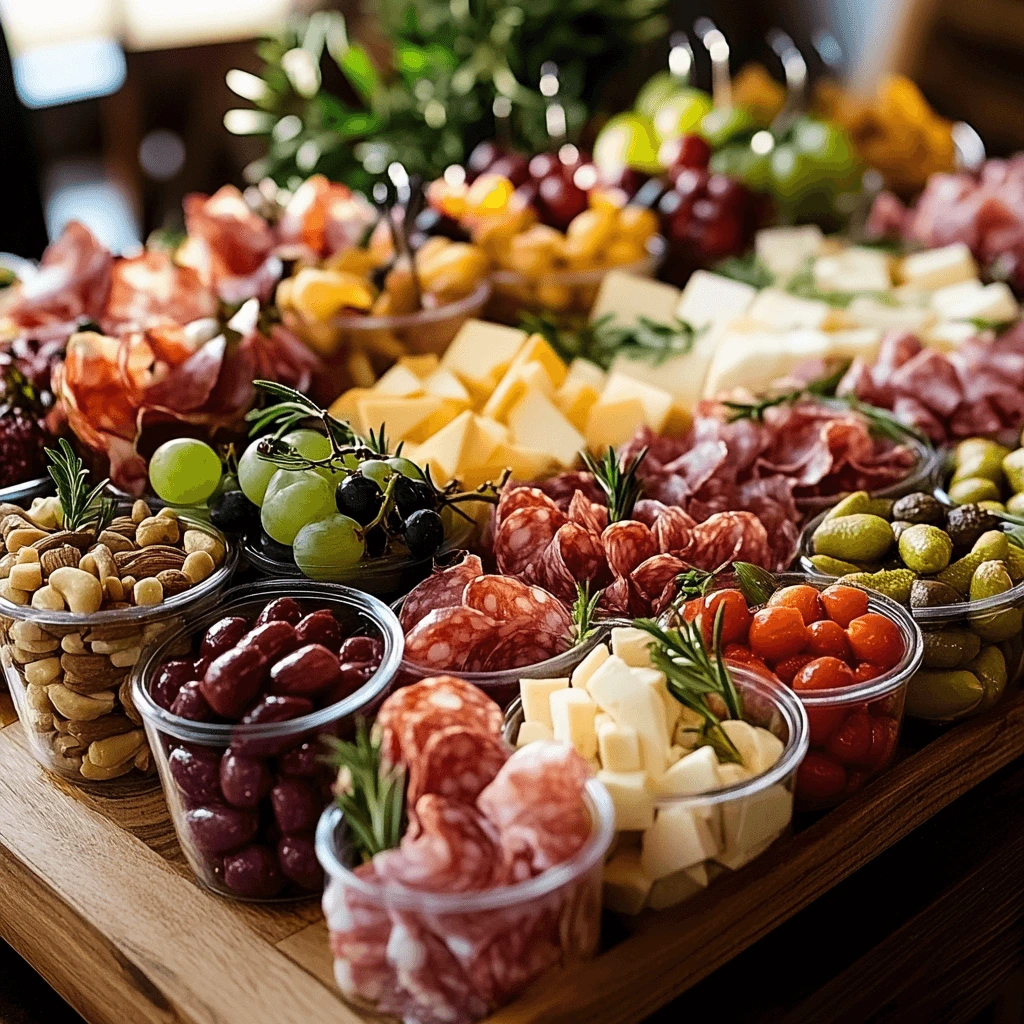
Fruits and Vegetables in Charcuterie Cups
The best part of creating individual charcuterie cups is the variety of ingredients you can use. Fruits and vegetables add color, texture, and contrast to the meats and cheeses. Here are a few options that work particularly well:
- Fresh Fruits: Grapes, apple slices, strawberries, figs, pears, and even pomegranate seeds provide a juicy sweetness that pairs perfectly with the saltiness of meats and the richness of cheeses.
- Dried Fruits: Apricots, raisins, or figs offer a chewy texture that complements the crunchy elements in the cup. Dried fruit is also a great option for outdoor events, as it’s more durable.
- Vegetables: Baby carrots, cucumber slices, and cherry tomatoes add freshness and crunch to balance the richness of the meats and cheeses.
Crackers, Nuts, and Extras for Charcuterie Cups
To complete your charcuterie cup, include a selection of complementary items like:
- Crackers or Breadsticks: Choose thin, crispy crackers or breadsticks that provide a satisfying crunch without overwhelming the flavors of the meats and cheeses.
- Nuts: Almonds, pistachios, and walnuts add a delightful crunch and pair well with both cheeses and meats.
- Extras: A drizzle of honey, a dollop of mustard, or a small jar of fruit preserves (like fig jam) can elevate the flavor profile of your charcuterie cup.
How to Make Simple Charcuterie Cups
Basic Charcuterie Cup Recipes for Beginners
If you’re just starting with charcuterie cups, it’s best to keep things simple. Start with a few basic ingredients:
- Meats: Choose one or two types of meat like prosciutto and salami.
- Cheeses: Include one or two cheeses like cheddar and brie.
- Crackers: Add a handful of crackers or breadsticks.
- Fruit: Add a small handful of grapes or strawberries.
- Extras: Include a small portion of mixed nuts or olives.
These basic ingredients come together to form a well-rounded and flavorful cup that’s easy to assemble and enjoyable to eat.
Quick Charcuterie Cup Ideas for Busy Hosts
For those who don’t have much time to prepare, you can always purchase pre-sliced meats, cheeses, and crackers from your local grocery store. This allows you to focus on adding some fun and colorful items like fresh berries, dried fruits, or a small jar of honey. With a few simple ingredients, you can quickly assemble beautiful and delicious individual charcuterie cups in no time.
Creative Variations of Individual Charcuterie Cups
Sweet Charcuterie Cups for Dessert Lovers
Charcuterie cups don’t always have to be savory! You can make dessert charcuterie cups by filling them with sweet treats like:
- Chocolate: Dark chocolate squares or chocolate truffles add richness and decadence to the cup.
- Pastries: Mini muffins, chocolate-dipped pretzels, or small cookies offer sweetness and variety.
- Fresh Fruit: Berries, pineapple, or melon can balance out the sweetness with a touch of freshness.
Themed Charcuterie Cups for Special Occasions
Charcuterie cups are easily customizable to fit any theme. For example, for a Halloween party, fill your cups with pumpkin-flavored treats, orange cheese, and black olives. For Christmas, consider using red and green fruits, holiday-themed crackers, and a sprinkle of cinnamon or nutmeg. Themed charcuterie cups add a special touch to any event and are sure to impress your guests.
Common Mistakes to Avoid When Making Charcuterie Cups
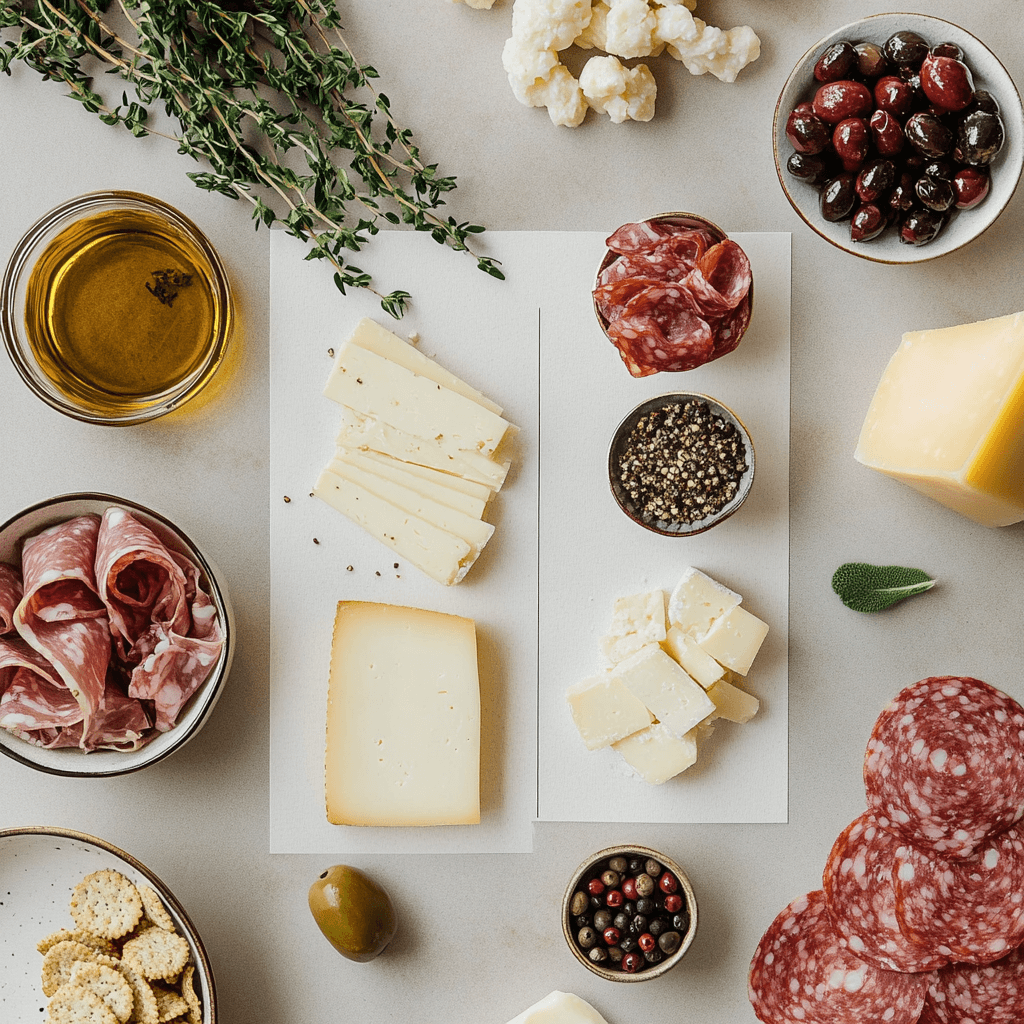
Overcrowding the Charcuterie Cup
While it’s tempting to include as many ingredients as possible, overcrowding your charcuterie cup can lead to a chaotic and unappealing presentation. Stick to a few well-chosen items that complement each other, leaving enough space to create a balanced look.
Not Paying Attention to Texture and Flavor Balance
A great charcuterie cup should offer a balance of flavors and textures. Be mindful of combining salty with sweet, crunchy with creamy, and rich with light. Avoid overwhelming the cup with too many strong-flavored items, and remember that contrast is key to creating a harmonious eating experience.
FAQ Section
What is the 3-3-3-3 Rule for Charcuterie Boards?
The 3-3-3-3 rule for charcuterie boards is a helpful guide for building a balanced spread. The rule suggests including three types of meats, three types of cheeses, three types of fruits, and three types of crackers or bread. This ensures a well-rounded selection with a variety of flavors and textures.
How Do You Assemble Individual Charcuterie Cups?
To assemble individual charcuterie cups, start by selecting a small container and layering the larger items first, such as meats and cheeses. Then, fill in the gaps with smaller items like fruits, crackers, and nuts. Finish with a garnish for extra flair.
How to Make Simple Charcuterie Cups?
For simple charcuterie cups, choose a few key ingredients, such as one or two types of meats, cheeses, fruits, and crackers. Arrange them neatly in a small container, and enjoy! You can always add a drizzle of honey or a few olives to complete the look.
What is a Charcuterie Cup Called?
A charcuterie cup is typically just referred to as a “charcuterie cup” or “personal charcuterie cup.” However, some may call it a “mini charcuterie board” or “gourmet snack cup.”
Conclusion
Individual charcuterie cups offer an easy yet elegant way to serve delicious, personalized bites for any occasion. Whether you’re hosting a large party, a family gathering, or simply enjoying a quiet snack, these charcuterie cups add a fun twist to traditional charcuterie boards. By following our simple steps and incorporating creative ingredients, you can assemble your own stylish and tasty cups.
https://charmedbycamille.com/easy-charcuterie-cups/
Print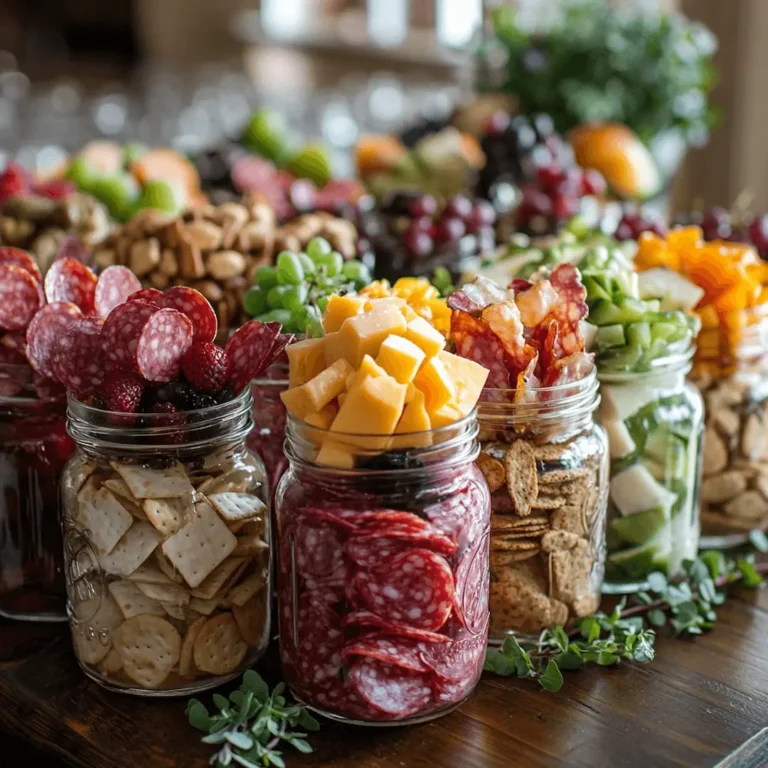
Create the Perfect Individual Charcuterie Cups: A Complete Guide
Individual charcuterie cups offer a unique and personalized twist on traditional charcuterie boards. These bite-sized servings are ideal for any occasion, providing guests with an elegant and hygienic way to enjoy a variety of delicious meats, cheeses, fruits, and more.
- Total Time: 15 minutes
- Yield: 12 servings
Ingredients
- Meats: Salami, Prosciutto, Pepperoni, Capicola or Soppressata
- Cheeses: Brie, Goat Cheese, Cheddar, Manchego or Gouda
- Fruits: Grapes, Apple slices, Strawberries, Figs, Pears, Pomegranate seeds
- Vegetables: Baby carrots, Cucumber slices, Cherry tomatoes
- Crackers/Breads: Thin crackers, Breadsticks
- Nuts: Almonds, Pistachios, Walnuts
- Extras: Honey, Mustard, Fruit preserves (e.g., fig jam)
Instructions
- Choose a small cup or jar for your charcuterie cup.
- Begin by layering the meats and cheeses, placing them in an appealing manner.
- Add crackers or small breadsticks, ensuring they don’t dominate the design.
- Fill the spaces with fruits and vegetables.
- Finish with a sprinkle of nuts and optional garnishes such as rosemary or thyme.
- For extra flair, drizzle honey or balsamic glaze and add decorative elements like fresh herbs or edible flowers.
Notes
For a visually stunning presentation, alternate textures and colors, and be mindful of balancing salty, sweet, crunchy, and creamy elements.
- Prep Time: 15 minutes
- Cook Time: 0 minutes
- Category: Appetizer
- Method: No Cook
- Cuisine: International
Nutrition
- Serving Size: 1 cup
- Calories: 300
- Sugar: 10g
- Sodium: 400mg
- Fat: 20g
- Saturated Fat: 8g
- Unsaturated Fat: 12g
- Trans Fat: 0g
- Carbohydrates: 15g
- Fiber: 3g
- Protein: 15g
- Cholesterol: 40mg
Keywords: charcuterie cups, appetizer, charcuterie, party food

